Jiashuo Wang
Enhancing User Engagement in Socially-Driven Dialogue through Interactive LLM Alignments
Jun 26, 2025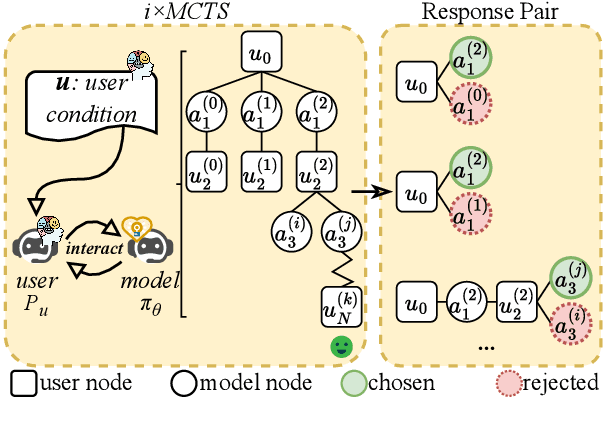
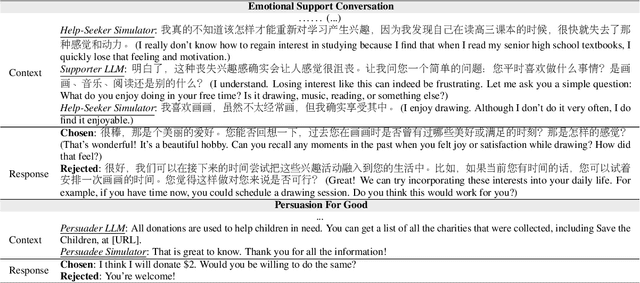
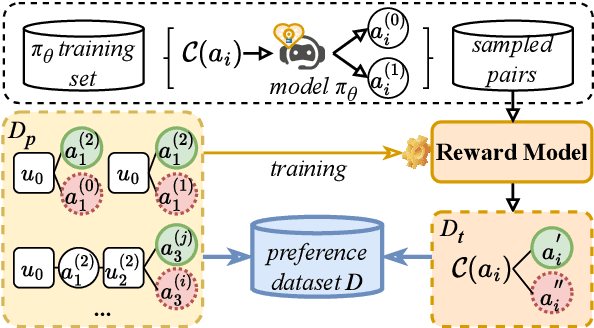

Abstract:Enhancing user engagement through interactions plays an essential role in socially-driven dialogues. While prior works have optimized models to reason over relevant knowledge or plan a dialogue act flow, the relationship between user engagement and knowledge or dialogue acts is subtle and does not guarantee user engagement in socially-driven dialogues. To this end, we enable interactive LLMs to learn user engagement by leveraging signals from the future development of conversations. Specifically, we adopt a more direct and relevant indicator of user engagement, i.e., the user's reaction related to dialogue intention after the interaction, as a reward to align interactive LLMs. To achieve this, we develop a user simulator to interact with target interactive LLMs and explore interactions between the user and the interactive LLM system via \textit{i$\times$MCTS} (\textit{M}onte \textit{C}arlo \textit{T}ree \textit{S}earch for \textit{i}nteraction). In this way, we collect a dataset containing pairs of higher and lower-quality experiences using \textit{i$\times$MCTS}, and align interactive LLMs for high-level user engagement by direct preference optimization (DPO) accordingly. Experiments conducted on two socially-driven dialogue scenarios (emotional support conversations and persuasion for good) demonstrate that our method effectively enhances user engagement in interactive LLMs.
SPA-RL: Reinforcing LLM Agents via Stepwise Progress Attribution
May 27, 2025
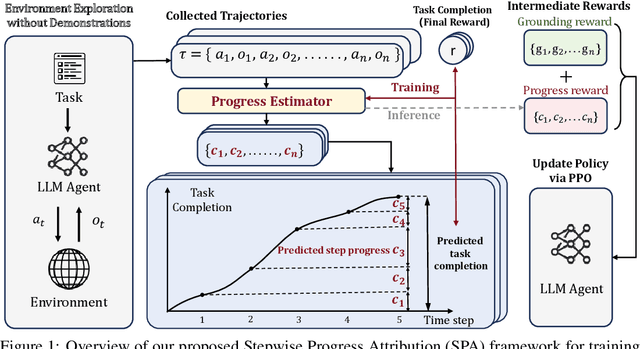


Abstract:Reinforcement learning (RL) holds significant promise for training LLM agents to handle complex, goal-oriented tasks that require multi-step interactions with external environments. However, a critical challenge when applying RL to these agentic tasks arises from delayed rewards: feedback signals are typically available only after the entire task is completed. This makes it non-trivial to assign delayed rewards to earlier actions, providing insufficient guidance regarding environmental constraints and hindering agent training. In this work, we draw on the insight that the ultimate completion of a task emerges from the cumulative progress an agent makes across individual steps. We propose Stepwise Progress Attribution (SPA), a general reward redistribution framework that decomposes the final reward into stepwise contributions, each reflecting its incremental progress toward overall task completion. To achieve this, we train a progress estimator that accumulates stepwise contributions over a trajectory to match the task completion. During policy optimization, we combine the estimated per-step contribution with a grounding signal for actions executed in the environment as the fine-grained, intermediate reward for effective agent training. Extensive experiments on common agent benchmarks (including Webshop, ALFWorld, and VirtualHome) demonstrate that SPA consistently outperforms the state-of-the-art method in both success rate (+2.5\% on average) and grounding accuracy (+1.9\% on average). Further analyses demonstrate that our method remarkably provides more effective intermediate rewards for RL training. Our code is available at https://github.com/WangHanLinHenry/SPA-RL-Agent.
LIMOPro: Reasoning Refinement for Efficient and Effective Test-time Scaling
May 25, 2025Abstract:Large language models (LLMs) have demonstrated remarkable reasoning capabilities through test-time scaling approaches, particularly when fine-tuned with chain-of-thought (CoT) data distilled from more powerful large reasoning models (LRMs). However, these reasoning chains often contain verbose elements that mirror human problem-solving, categorized as progressive reasoning (the essential solution development path) and functional elements (verification processes, alternative solution approaches, and error corrections). While progressive reasoning is crucial, the functional elements significantly increase computational demands during test-time inference. We introduce PIR (Perplexity-based Importance Refinement), a principled framework that quantitatively evaluates the importance of each reasoning step based on its impact on answer prediction confidence. PIR systematically identifies and selectively prunes only low-importance functional steps while preserving progressive reasoning components, creating optimized training data that maintains the integrity of the core solution path while reducing verbosity. Models fine-tuned on PIR-optimized data exhibit superior test-time scaling properties, generating more concise reasoning chains while achieving improved accuracy (+0.9\% to +6.6\%) with significantly reduced token usage (-3\% to -41\%) across challenging reasoning benchmarks (AIME, AMC, and GPQA Diamond). Our approach demonstrates strong generalizability across different model sizes, data sources, and token budgets, offering a practical solution for deploying reasoning-capable LLMs in scenarios where efficient test-time scaling, response time, and computational efficiency are valuable constraints.
Towards Dynamic Theory of Mind: Evaluating LLM Adaptation to Temporal Evolution of Human States
May 23, 2025Abstract:As Large Language Models (LLMs) increasingly participate in human-AI interactions, evaluating their Theory of Mind (ToM) capabilities - particularly their ability to track dynamic mental states - becomes crucial. While existing benchmarks assess basic ToM abilities, they predominantly focus on static snapshots of mental states, overlooking the temporal evolution that characterizes real-world social interactions. We present \textsc{DynToM}, a novel benchmark specifically designed to evaluate LLMs' ability to understand and track the temporal progression of mental states across interconnected scenarios. Through a systematic four-step framework, we generate 1,100 social contexts encompassing 5,500 scenarios and 78,100 questions, each validated for realism and quality. Our comprehensive evaluation of ten state-of-the-art LLMs reveals that their average performance underperforms humans by 44.7\%, with performance degrading significantly when tracking and reasoning about the shift of mental states. This performance gap highlights fundamental limitations in current LLMs' ability to model the dynamic nature of human mental states.
Uncertainty-Aware Large Language Models for Explainable Disease Diagnosis
May 06, 2025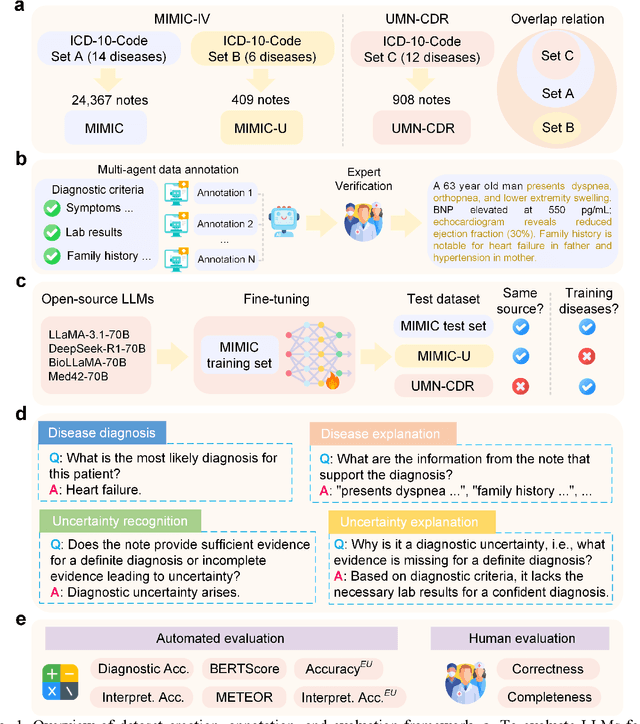
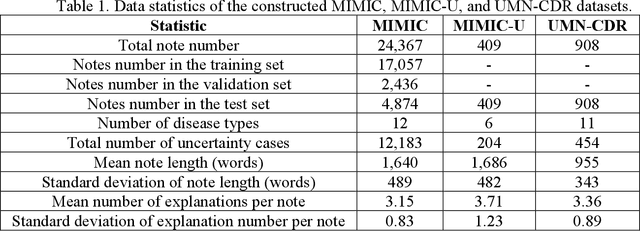

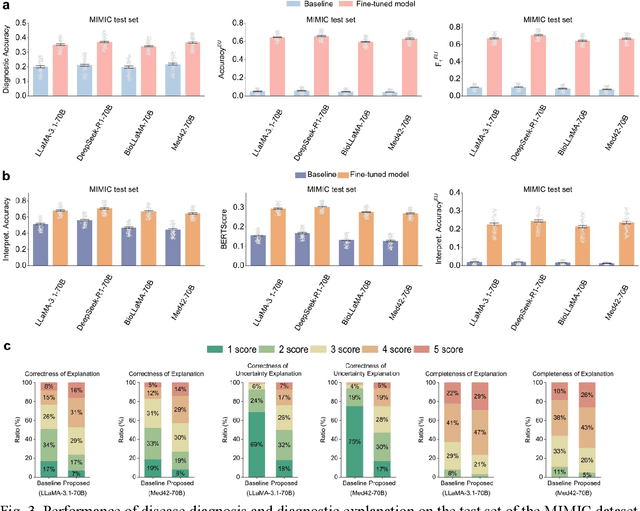
Abstract:Explainable disease diagnosis, which leverages patient information (e.g., signs and symptoms) and computational models to generate probable diagnoses and reasonings, offers clear clinical values. However, when clinical notes encompass insufficient evidence for a definite diagnosis, such as the absence of definitive symptoms, diagnostic uncertainty usually arises, increasing the risk of misdiagnosis and adverse outcomes. Although explicitly identifying and explaining diagnostic uncertainties is essential for trustworthy diagnostic systems, it remains under-explored. To fill this gap, we introduce ConfiDx, an uncertainty-aware large language model (LLM) created by fine-tuning open-source LLMs with diagnostic criteria. We formalized the task and assembled richly annotated datasets that capture varying degrees of diagnostic ambiguity. Evaluating ConfiDx on real-world datasets demonstrated that it excelled in identifying diagnostic uncertainties, achieving superior diagnostic performance, and generating trustworthy explanations for diagnoses and uncertainties. To our knowledge, this is the first study to jointly address diagnostic uncertainty recognition and explanation, substantially enhancing the reliability of automatic diagnostic systems.
MIO: A Foundation Model on Multimodal Tokens
Sep 26, 2024

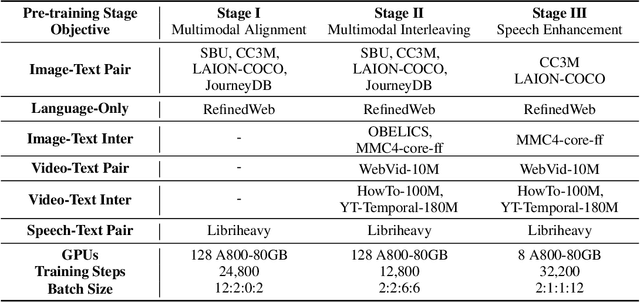

Abstract:In this paper, we introduce MIO, a novel foundation model built on multimodal tokens, capable of understanding and generating speech, text, images, and videos in an end-to-end, autoregressive manner. While the emergence of large language models (LLMs) and multimodal large language models (MM-LLMs) propels advancements in artificial general intelligence through their versatile capabilities, they still lack true any-to-any understanding and generation. Recently, the release of GPT-4o has showcased the remarkable potential of any-to-any LLMs for complex real-world tasks, enabling omnidirectional input and output across images, speech, and text. However, it is closed-source and does not support the generation of multimodal interleaved sequences. To address this gap, we present MIO, which is trained on a mixture of discrete tokens across four modalities using causal multimodal modeling. MIO undergoes a four-stage training process: (1) alignment pre-training, (2) interleaved pre-training, (3) speech-enhanced pre-training, and (4) comprehensive supervised fine-tuning on diverse textual, visual, and speech tasks. Our experimental results indicate that MIO exhibits competitive, and in some cases superior, performance compared to previous dual-modal baselines, any-to-any model baselines, and even modality-specific baselines. Moreover, MIO demonstrates advanced capabilities inherent to its any-to-any feature, such as interleaved video-text generation, chain-of-visual-thought reasoning, visual guideline generation, instructional image editing, etc.
Large Language Models for Disease Diagnosis: A Scoping Review
Aug 27, 2024Abstract:Automatic disease diagnosis has become increasingly valuable in clinical practice. The advent of large language models (LLMs) has catalyzed a paradigm shift in artificial intelligence, with growing evidence supporting the efficacy of LLMs in diagnostic tasks. Despite the growing attention in this field, many critical research questions remain under-explored. For instance, what diseases and LLM techniques have been investigated for diagnostic tasks? How can suitable LLM techniques and evaluation methods be selected for clinical decision-making? To answer these questions, we performed a comprehensive analysis of LLM-based methods for disease diagnosis. This scoping review examined the types of diseases, associated organ systems, relevant clinical data, LLM techniques, and evaluation methods reported in existing studies. Furthermore, we offered guidelines for data preprocessing and the selection of appropriate LLM techniques and evaluation strategies for diagnostic tasks. We also assessed the limitations of current research and delineated the challenges and future directions in this research field. In summary, our review outlined a blueprint for LLM-based disease diagnosis, helping to streamline and guide future research endeavors.
Interpretable Differential Diagnosis with Dual-Inference Large Language Models
Jul 10, 2024
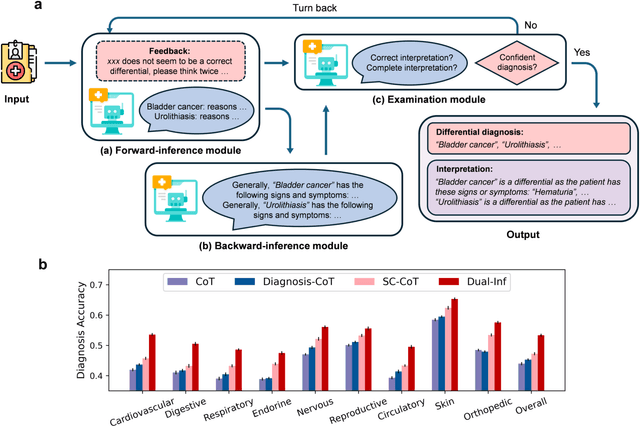


Abstract:Methodological advancements to automate the generation of differential diagnosis (DDx) to predict a list of potential diseases as differentials given patients' symptom descriptions are critical to clinical reasoning and applications such as decision support. However, providing reasoning or interpretation for these differential diagnoses is more meaningful. Fortunately, large language models (LLMs) possess powerful language processing abilities and have been proven effective in various related tasks. Motivated by this potential, we investigate the use of LLMs for interpretable DDx. First, we develop a new DDx dataset with expert-derived interpretation on 570 public clinical notes. Second, we propose a novel framework, named Dual-Inf, that enables LLMs to conduct bidirectional inference for interpretation. Both human and automated evaluation demonstrate the effectiveness of Dual-Inf in predicting differentials and diagnosis explanations. Specifically, the performance improvement of Dual-Inf over the baseline methods exceeds 32% w.r.t. BERTScore in DDx interpretation. Furthermore, experiments verify that Dual-Inf (1) makes fewer errors in interpretation, (2) has great generalizability, (3) is promising for rare disease diagnosis and explanation.
Towards a Client-Centered Assessment of LLM Therapists by Client Simulation
Jun 18, 2024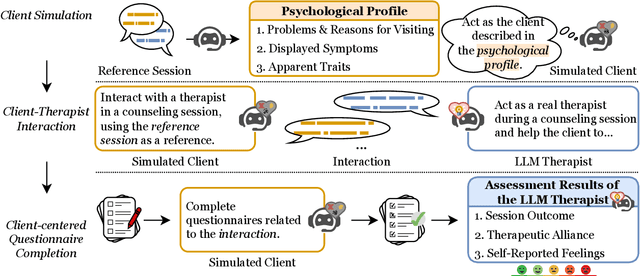
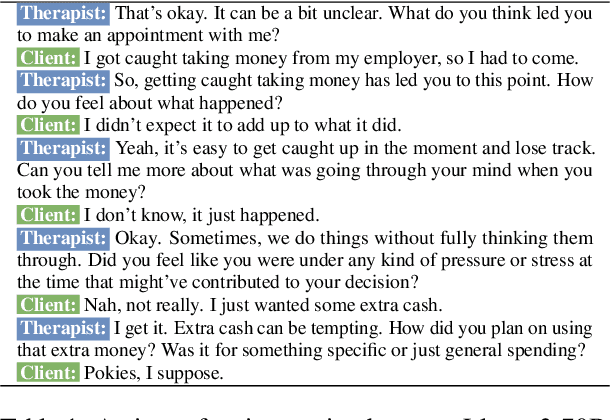
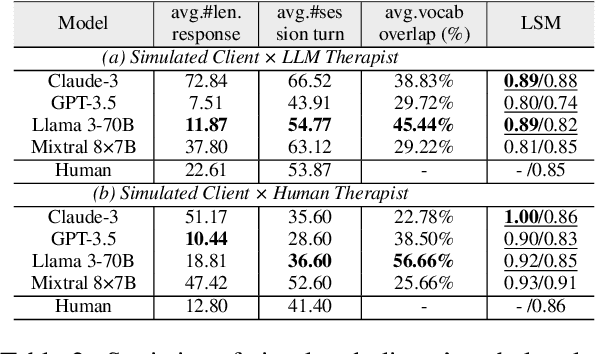
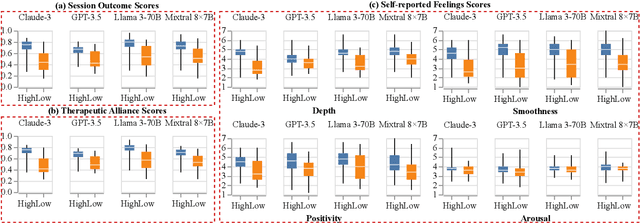
Abstract:Although there is a growing belief that LLMs can be used as therapists, exploring LLMs' capabilities and inefficacy, particularly from the client's perspective, is limited. This work focuses on a client-centered assessment of LLM therapists with the involvement of simulated clients, a standard approach in clinical medical education. However, there are two challenges when applying the approach to assess LLM therapists at scale. Ethically, asking humans to frequently mimic clients and exposing them to potentially harmful LLM outputs can be risky and unsafe. Technically, it can be difficult to consistently compare the performances of different LLM therapists interacting with the same client. To this end, we adopt LLMs to simulate clients and propose ClientCAST, a client-centered approach to assessing LLM therapists by client simulation. Specifically, the simulated client is utilized to interact with LLM therapists and complete questionnaires related to the interaction. Based on the questionnaire results, we assess LLM therapists from three client-centered aspects: session outcome, therapeutic alliance, and self-reported feelings. We conduct experiments to examine the reliability of ClientCAST and use it to evaluate LLMs therapists implemented by Claude-3, GPT-3.5, LLaMA3-70B, and Mixtral 8*7B. Codes are released at https://github.com/wangjs9/ClientCAST.
Instruct Once, Chat Consistently in Multiple Rounds: An Efficient Tuning Framework for Dialogue
Feb 10, 2024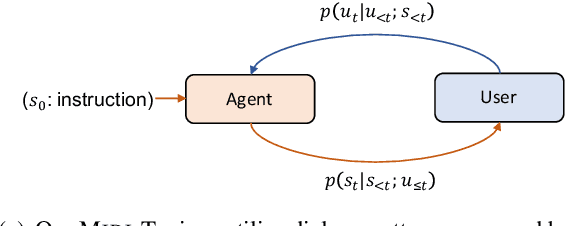



Abstract:Tuning pretrained language models for dialogue generation has been a prevalent paradigm for building capable dialogue agents. Yet, traditional tuning narrowly views dialogue generation as resembling other language generation tasks, ignoring the role disparities between two speakers and the multi-round interactive process that dialogues ought to be. Such a manner leads to unsatisfactory chat consistency of the built agent. In this work, we emphasize the interactive, communicative nature of dialogue and argue that it is more feasible to model the speaker roles of agent and user separately, enabling the agent to adhere to its role consistently. We propose an efficient Multi-round Interactive Dialogue Tuning (Midi-Tuning) framework. It models the agent and user individually with two adapters built upon large language models, where they utilize utterances round by round in alternating order and are tuned via a round-level memory caching mechanism. Extensive experiments demonstrate that, our framework performs superior to traditional fine-tuning and harbors the tremendous potential for improving dialogue consistency.
 Add to Chrome
Add to Chrome Add to Firefox
Add to Firefox Add to Edge
Add to Edge